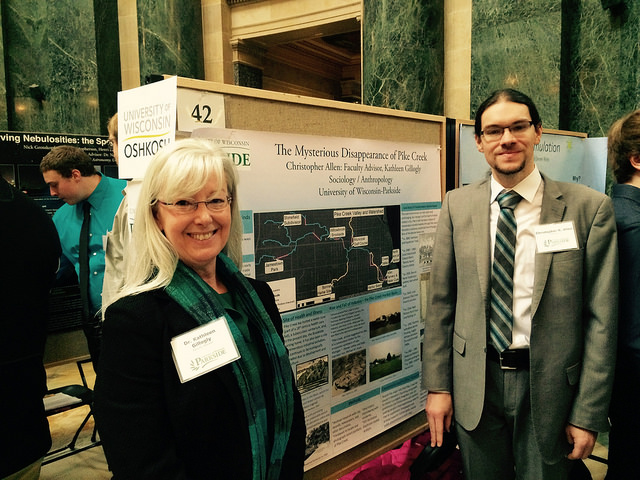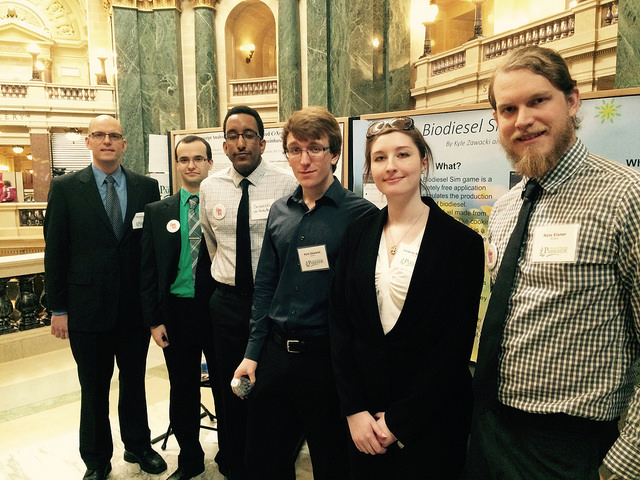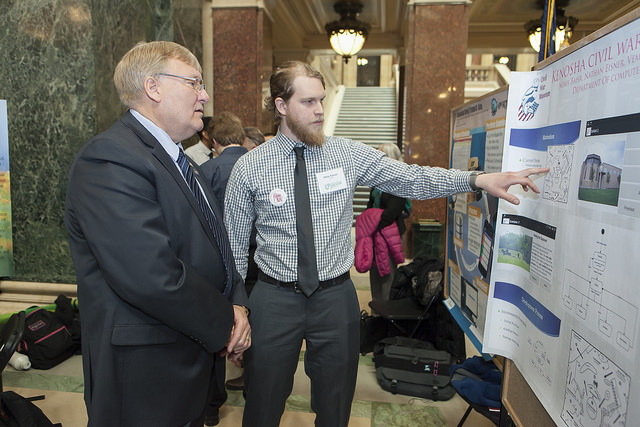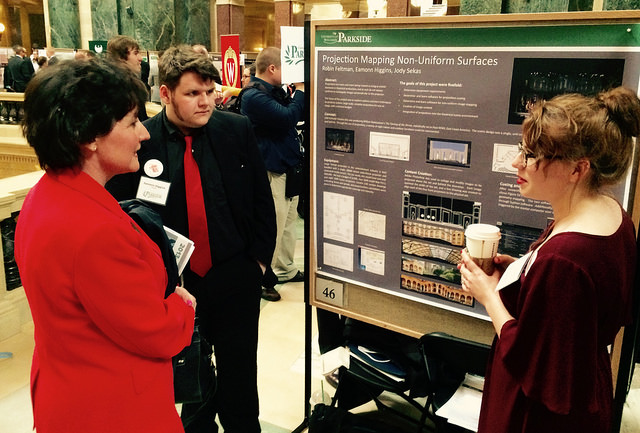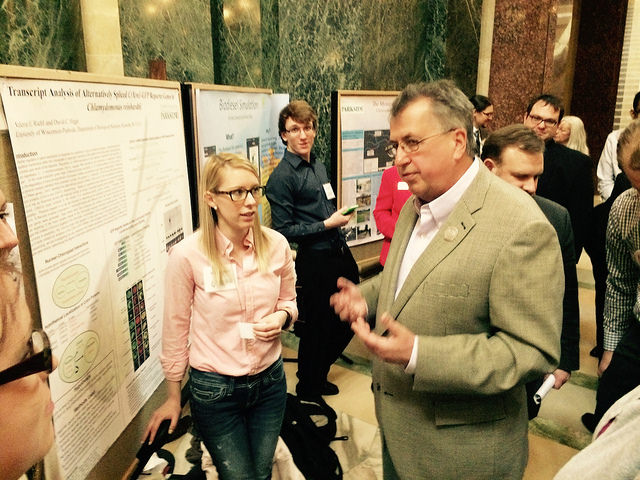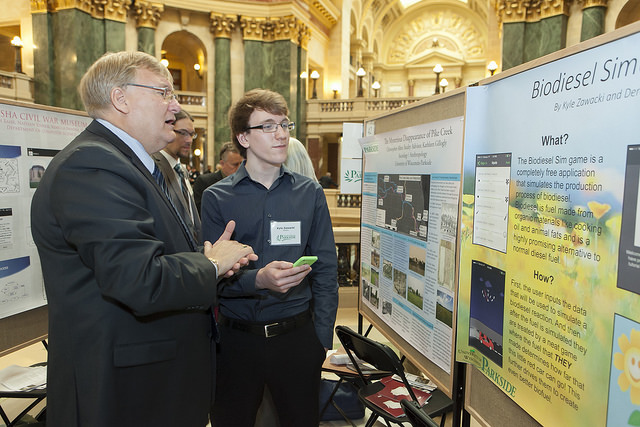'Posters in the Rotunda' showcases undergraduate research
Published: April 23, 2015
Flickr photo album from Posters in the Rotunda
The UW-Parkside contingent featured three research projects that use mobile app technology: biodiesel, Kenosha Civil War Museum, and Kenosha Area Transit.
UW-Parkside students and their research topics- Christopher Allen, Kenosha - The Mysterious Disappearance of Pike Creek
The Pike Creek waterway is quite visible in some parts of the city of Kenosha. And then there are parts where you would expect to see it, but it's not there – or at least it is not visible. Allen's research explores the legacy of Pike Creek. Originally, bodies of water such as the Pike Creek were important for industrial and utilitarian purposes. "As we moved away from water transit to railroads they become less valuable and kind of a nuisance," Allen said. "Now, cities are realizing that these water resources are really critical in terms of development." Pike Creek suffered from industrial and agricultural use that left it in a polluted state. "Because a lot of people are not conscious of the existence of Pike Creek as a watershed, it's not managed very well," Allen said. Today, however, important discussions about freshwater resources are taking place around the world. In southeastern Wisconsin, government and community organizations are working to protect our regional gems: Lake Michigan, the source of our drinking water, and the rivers and creeks that feed into the lake. Pike Creek flows into Lake Michigan, even though much of the creek is flowing underground. Allen said it could be a recreation and development resource for the city, much like a waterway in Kalamazoo, Mich. "There was a downtown water course in a tunnel and the city day-lighted it," Allen said. "Now it is a significant attraction for downtown Kalamazoo. I think things like that could be done here in Kenosha." During Allen's research he discovered that the Kenosha Water Cure building (a popular form of therapy in the 1800s) was one of the first buildings on Pike Creek. "Five or six years after that," Allen said, "a large tannery opened next door. It was like thinking of a health spa next to a water treatment plant. "I think that helps highlight how varied the history of this body of water has been."
- Valerie Berglind, Lake Forest, Ill., Andrew Foxworth, Racine, and Bereket Kifle, Kenosha - Kenosha Area Transit Mobile App
The answer to the age-old question, "I wonder when the next bus is coming?" will be a snap for Kenosha Area Transit (KAT) riders with a smartphone thanks to students in the UW-Parkside App Factory. Parkside computer science students, including Berglind, Foxworth and Kifle, working in conjunction with KAT, developed a mobile app for Android and iPhone platforms that lets riders know when the next bus is coming. In addition to taking some of the stress out of the bus-riding experience, the app has reduced the amount of time KAT staff spends answering the phone calls asking: "When is the next bus coming?"
- Nathan Eisner, Racine - Kenosha Civil War Museum Mobile App
One of the goals in building the app was to effectively serve a variety of audiences that visit and interact with the museum and its exhibits. Eisner said it was a challenge trying to balance the needs of such a diverse group of visitors. "We didn't want to make it too complicated," he said. "The app starts off with a map that visitors currently get on paper. With the app, however, visitors can click on an exhibit and have more information including photos and links to videos. The app helps visitors navigate the museum so they don't miss a certain exhibit. It also helps inform visitors, even when they are not at the museum. If someone is interested in a particular aspect of the exhibit, they can learn more about it from the comfort of their living room. "First, it's a navigation tool to help visitors make sure they don't miss anything," Eisner said. "It also helps the museum staff update information more quickly to ensure that visitors are informed to the fullest." Eisner said the project helped him discover how much he enjoys app development.
- Robin Feltman, Pleasant Prairie, and Eamonn Higgins, Milwaukee - Projection Mapping Non-Uniform Surfaces for Theatre Arts
The research, Higgins said, gave students the opportunity to use new and upcoming technologies. One of the challenges was figuring out how to make a normal rectangle fit on what is more like a rhombus. "We came up with the combination of two softwares," Higgins said, "QLab for all the official cueing and MadMapper that lets us take rectangles and turn them into rhombuses and circles and other shapes." They also used multiple projectors. "All together we had about eight projectors," Feltman said. "It involved a lot of trouble shooting Originally we started with two projectors and we found that really wasn't powerful enough so we had to add more."
- Brian Liesch, Racine - Spatial Variability of Sediment and Glacial Processes on a Recessional Moraine of the Lake Michigan Lobe
- Valerie Riehl, Kenosha - Analysis of alternatively spliced CrXrn1-GFP reporter gene mRNAs in the green alga Chlamydomonas reinhardtii
For some, the value of research is in the research itself. Riehl's project allowed her to work with the tools of research including the conversion of microliters to milliliters, and moles to grams. In other words, she was preparing for success in a career or at graduate school. In the case of Analysis of alternatively spliced CrXrn1-GFP reporter gene mRNAs in the green alga Chlamydomonas reinhardtii, Riehl mutated different strains of algae, added GFP (a protein that fluoresces under light), isolated the RNA from the algae and ran the RNA out on a gel. The process of isolating RNA is quite common in biology research and now Riehl better understands the process. She began her academic career in business, then switched to biology. "A business degree is more common," Riehl said. "I wanted something that not many people have." After considering a career in pharmacy, Riehl quickly discovered that she enjoyed lab work. "I don't want to be behind the counter selling medicines," she said, "I want to be in the lab creating medicines."
- Kyle Zawacki, Racine - Biodiesel Simulation Game Mobile App
The Biodiesel Sim game is a completely free mobile app that simulates the production process of biodiesel, a promising alternative diesel fuel made from organic materials like cooking oil and animal fats. "I learned how to make iOS apps from this project," Zawacki said. "In the span of one semester, my programming skills have tripled just by doing this project." The user inputs data used to simulate a biodiesel reaction. The game then shows how far a little red car can go on the fuel that was made. The app is available in the iOS app store as an iPad only app. A revamped iPhone version is expected soon.
